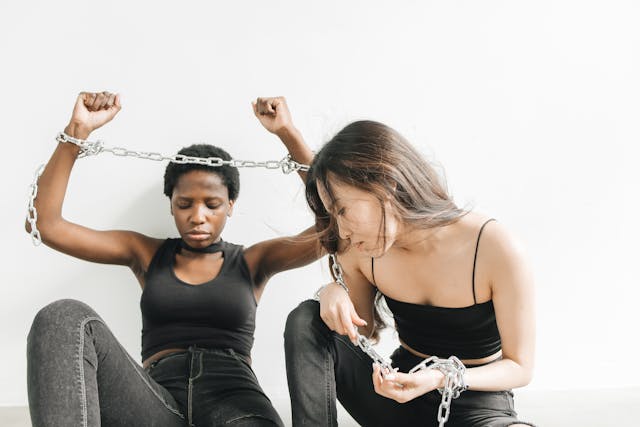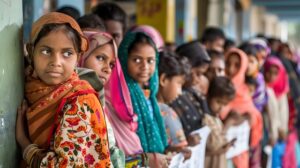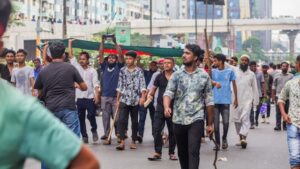Introduction
When we speak of freedom of expression, we often think of grand speeches, protest signs, or images of journalists reporting in conflict zones. Yet for those of us who live in marginal positions of society, freedom of expression is much more personal and in many cases also dangerous. It is the right to accept our existence spontaneously, the right to love whom we wish to love, and the right to dream beyond the boundaries drawn by our circumstances. My journey from a poor family in rural Bangladesh to joining the movement for protecting human rights has taught me that freedom of expression is not just about words, it is the basic right to claim our human rights while standing against institutional oppression.
The Universal Declaration of Human Rights, which was adopted in 1948, recognized freedom of expression as the foundation of human dignity (United Nations, 1948). In its Article 19 it says, “Everyone has the right to freedom of opinion and expression; this right includes freedom to hold opinions without interference and to seek, receive and impart information and ideas through any media and regardless of frontiers.” But in real life, especially if we think about a society like Bangladesh, the story is different for women, minorities, and marginalized groups—where expressing basic needs like education, love, or equality can face violence, exclusion, and institutional barriers.
The silent violence of suppressed expression
In my real life I have witnessed how poverty and gender discrimination together create multiple layers of silent repression. When my elder sister was married off at a young age to reduce our family’s financial burden, and the abuse after marriage became an open secret that no one dared to mention. Her suffering became normal, her voice was deliberately erased through silently accepting violence as inevitable.
In a patriarchal society like Bangladesh, violence against women is reflected through suppressing their most basic self-expression. The desire for education, the right to choose a life partner, or the attempt to speak against injustice—everything becomes a dangerous step.
Research by UN Women has repeatedly shown that women’s freedom of expression is limited not only by direct censorship, but also by economic dependency, social isolation, and threats of violence (UN Women, 2020).
Workplace battlefield: when self-expression meets harassment
After entering professional life for financial stability and personal development, I realized that freedom of expression is not limited to words or pages of books, it is also tied to how we can appear in public. In my first job, at a buying house, the sexual harassment I faced was not only unwanted behavior—it was a systematic effort to silence me, in a place where my financial independence had become a threat to traditional power structures.
According to the International Labour Organization, almost 35% of women worldwide have faced sexual harassment in workplaces; in countries like Bangladesh where reporting systems are weak and social stigma is strong, this number is likely much higher (ILO, 2017). When I was forced to leave that job despite urgent financial needs, I joined those millions of women whose freedom of expression is diminished through economic coercion and workplace violence.
In my second job, in the garment industry, harassment became more intense because of my interfaith marriage. There my personal decisions turned into grounds for professional abuse, showing that freedom of expression is not limited to words but includes the right to love and the freedom to form relationships according to one’s conscience. The intersection of religious discrimination and gender-based violence created such a hostile environment that it became impossible for me to continue my job.
Loving across religious boundaries: the highest expression of freedom
In a Muslim-majority society, my marriage to a Buddhist man is perhaps the most risky self-expression of my life. Although in Bangladesh there is no clear law against interfaith marriage, the social punishment can be severe—from family rejection to physical violence (Ain o Salish Kendra, 2019). Our relationship survives in a space of forced invisibility, where showing love openly means the possibility of terrible consequences.
This forced secrecy highlights an important aspect of freedom of expression often ignored in academic discussions—the right to intimate expression, to build relationships that reflect our deepest values, not society’s expectations. When my husband and I have to hide our marriage, not only is our right to speak of love taken away, but also our right to live in society in our true form is denied.
Research by Human Rights Watch shows that restrictions on interfaith relationships affect women disproportionately; women face more severe consequences than men for breaking religious boundaries (Human Rights Watch, 2021). The harassment we endured from family members, neighbors, and colleagues reflects a broader picture where women’s choices in intimate relationships are controlled to suppress their overall freedom.
Global context: Bangladesh and universal struggle
My story unfolds in a specific national context, where freedom of expression faces special challenges. In its 2023 report, Freedom House said Bangladesh scored 39/100 in political rights and civil liberties, where significant restrictions exist on freedom of expression, assembly, and association (Freedom House, 2023). Digital surveillance and cyber security laws have created new forms of censorship, especially affecting women and minorities—those who use online spaces to organize and express different opinions.
But the struggle I have faced is not unique to Bangladesh. Worldwide, women encounter similar barriers due to the intersection of gender, class, religion, and nationality, which limit their freedom of expression. A 2022 Pew Research Center study found that women are more likely than men to face harassment online. Especially outspoken women and religious minority women suffer abuse at higher rates (Pew Research Center, 2022).
To understand this global context, it is important to see that freedom of expression cannot be solved only through legal frameworks. Although international human rights law provides important protection, implementation requires breaking the underlying structures of discrimination that make self-expression dangerous for marginalized groups.
Technology and new horizons of expression
The digital revolution has given marginalized voices unprecedented opportunities—to bypass traditional controllers and reach global audiences. My website is only one example of how women in restricted societies can use technology to express ideas and build communities that could never exist in offline spaces. A decade ago, I might not even have imagined such things.
But technology also creates new kinds of silence. Research by the Web Foundation shows that women are 50% more likely than men to face online abuse, where harassment often targets their gender, sexuality, or appearance (Web Foundation, 2020). For people like me who write about interfaith marriage or women’s rights, online platforms can become sites of intense abuse.
The economic dimension of freedom of expression
Throughout my journey, economic limitations repeatedly obstructed my self-expression. The need to work alongside study, to take care of younger brothers, to fight workplace harassment—all show how economic vulnerability combines with other oppressions to limit freedom of expression.
In human rights literature, the relationship between economic rights and the right to expression is well established. The International Covenant on Economic, Social and Cultural Rights recognizes that without basic economic security, political and civil rights largely remain theoretical (United Nations, 1966).
This economic dimension is especially relevant to understanding women’s expression in a global context. When women lack independent income, they are deprived of the chance to express dissent, to leave abusive relationships, or to break traditions and take new paths. So economic empowerment is not just a developmental goal, but a precondition for meaningful freedom of expression.
Horizons of the future: from personal healing to institutional change
By working with minority rights organizations I have learned that sustainable progress requires bringing together different forms of knowledge—lived experience and academic theory, local tradition and international frameworks, personal healing and collective action. The goal is not to replace one kind of authority with another; rather to create spaces where multiple voices can enrich our understanding of freedom and justice.
The dream of a society free from discrimination against women and minorities may seem imaginary in present reality. But history shows that seemingly impossible changes can happen—when enough people refuse to accept injustice as inevitable. The civil rights movement in the United States, the struggle against apartheid in South Africa, and the ongoing LGBTQ+ rights movements worldwide—all started with a few people who decided that the price of silence was greater than the value of their words.
Conclusion: expression is resistance, resistance is hope
Freedom of expression is never limited to words alone. It is the right to live fully in the world—to love whom we choose, to follow dreams despite circumstances, and to speak truth even when that truth makes others uncomfortable. For marginalized communities like us, every act of genuine expression becomes resistance against systems built to silence and erase us.
My journey from a poverty-stricken family in Bangladesh to becoming an activist for human rights shows both the barriers that limit expression and the transformative power that is born when we refuse to stay silent. The harassment I faced for education, the discrimination for marrying a man of another religion, and the violence that forced me to leave multiple workplaces—these are not just my personal experiences but a wider picture of repression affecting millions of women worldwide.
Yet the same experiences showed me a strange resilience that is born when people are deprived of basic rights. Every time I sat for exams despite financial crisis, every time I continued study beside my mother’s deathbed, every time I spoke truth instead of staying silent—I joined that global movement where people refuse to surrender to injustice.
The road ahead demands both personal courage and collective action. It reminds us that freedom of expression is not a luxury reserved only for the privileged, but a fundamental human right that must be actively protected and expanded. It teaches us that expression is not limited to words but is present in every medium of human connection.
As I continue this work, I carry with me the voice of my sister still trapped in an abusive marriage; the voices of countless girls who left school to take family responsibility; the voices of couples whose love must stay hidden due to religious or ethnic divisions; and the dreams of those whose aspirations are deemed impossible by their circumstances. Their silent voices are for me an urgent call—to expand freedom of expression for all.
In places where our voices are systematically excluded, every word becomes an act of revolution. In societies where our dreams are called impossible, every achievement becomes a declaration of possibility. And in contexts where our very existence is questioned, every genuine expression becomes a declaration of our indestructible human dignity.
That is why freedom of expression is important—not only as a legal principle or political ideal, but as a practice of life through which we claim our right to shape our own world. Through expression we become not the objects of others’ decisions but the makers of our own liberation. Through expression we discover that our personal struggles are in fact linked with the universal longing for dignity, equality, and justice.
This work continues, sustained by the belief that every truth spoken brings us closer to the world we wish to build—a world where freedom of expression is not a permitted privilege, but a birthright to be celebrated.
References:
1. Universal Declaration of Human Rights (1948)
- Article Reference: United Nations, 1948 – Article 19
- Available Links:
- Official UN Link: https://www.un.org/en/about-us/universal-declaration-of-human-rights
2. UN Women (2020)
- Article Reference: UN Women, 2020 – regarding women’s freedom of expression limitations
- Available Links:
-
- UN Women Annual Report 2019-2020: https://www.unwomen.org/en/digital-library/publications/2020/06/annual-report-2019-2020
-
3. International Covenant on Economic, Social and Cultural Rights
- Article Reference: United Nations, 1966 – relationship between economic rights and expression.
- General UN Treaties Link: https://www.ohchr.org/en/instruments-mechanisms/instruments/international-covenant-economic-social-and-cultural-rights
4. UN Women Expert Group Meeting on Expression
5. International Labour Organization (ILO, 2017) – Ending violence and harassment in the world of work
🔗 https://www.ilo.org/global/topics/violence-harassment/lang–en/index.htm
6. Human Rights Watch (2021) – Restrictions on interfaith marriage and women’s rights
🔗 https://www.hrw.org/world-report/2021
7. Freedom House (2023) – Freedom in the World Report: Bangladesh
🔗 https://freedomhouse.org/country/bangladesh/freedom-world/2023
8. Web Foundation (2020) – Women’s Rights Online: Online gender-based violence
🔗 https://webfoundation.org/research/womens-rights-online-2020/
9. United Nations (1966) – International Covenant on Economic, Social and Cultural Rights (ICESCR)
🔗 https://www.ohchr.org/en/instruments-mechanisms/instruments/international-covenant-economic-social-and-cultural-rights




